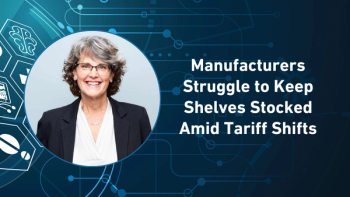
Data Quality and Skill Gaps Pose Major Barriers to AI Adoption
In the second part of her Pharma Commerce video interview, Christy Christian, senior industry principal with Kinaxis, shares how transitioning from spreadsheets to AI-driven orchestration requires more than new technology—it demands clean, reliable data and a workforce ready to interpret and act on insights.
Global trade tensions and shifting tariff policies are creating significant challenges for manufacturers as they work to maintain product availability on retail shelves. According to Christy Christian, senior industry principal with Kinaxis, these disruptions are not entirely new, but the pace and unpredictability of change have intensified. Manufacturers now face a rapidly evolving landscape where tariffs can shift overnight—from metals to paper to other key materials—making it difficult to maintain stable, long-term supply chain strategies.
A key issue lies in the extended and globally distributed nature of modern supply chains. Many companies source components or raw materials from regions far from where final products are assembled, which introduces delays and reduces flexibility in responding to sudden tariff changes. The cascading effects of such disruptions extend across tier one, tier two, and tier three suppliers, amplifying bottlenecks and vulnerabilities.
Traditionally, companies have mitigated supply chain risk by building inventory buffers. However, in today’s financial climate, organizations are less willing or able to tie up capital in excess inventory. Maintaining large stockpiles directly impacts free cash flow, which remains a top priority for many manufacturers. This constraint leaves supply chains with limited slack and little room for error when disruptions occur.
As a result, firms must find ways to optimize and adapt their networks within increasingly complex conditions. Agility—both in planning and execution—has become essential. Companies need to rapidly update sourcing strategies, reallocate inventory, and pivot operations in response to tariff shifts or supplier closures. Yet, the challenge is ensuring that adjustments happen quickly enough to prevent excess raw materials from arriving after market conditions have changed. In today’s volatile global environment, the ability to dynamically balance inventory, cash flow, and sourcing flexibility defines supply chain resilience.
Christian also comments on the hurdles that typically come with moving from manual spreadsheets to AI-powered orchestration in the healthcare supply chain, the reliability of AI-driven demand forecasts in the face of unpredictable events; how supply chain modernization directly affects the affordability and accessibility of OTC medicines; and more.
A transcript of her conversation with PC can be found below.
PC: What hurdles typically come with moving from manual spreadsheets to AI-powered orchestration, especially when taking the healthcare supply chain into consideration?
Christian: One of the biggest hurdles are going to be clean data, so in order to have AI provide the results that it's capable of, the data that it's using needs to be clean. What I have seen in my career, and what I think you have probably already witnessed, is that's not always the case, and that's a big undertaking to get that initial foundation clean and ready, but if we rely on AI to leverage data that we have inconsistencies or less confidence in, you're going to be right back to spreadsheets.
You've invested in the technology, but the trust isn't in the outcome of it. We're no further ahead, and so when you think about the level of change management that needs to happen—I kind of mentioned there's a different skillset—I think that's going to be one of the fundamental challenges that are going to happen, along with the data, is that the skillset of a supply planner isn't going to be somebody who's happy being in a spreadsheet. It's somebody who can take three or four or five data points, tell a story, and drive a decision.
Even if we're only 80% confident, we need to tell a story, get alignment, take a decision, and then if those assumptions change, we'll pivot, but sitting there at that tee in the road and not making a decision—we don't have that luxury anymore. When you think about the data and the skillsets, I think those are two of the biggest challenges that they're going to face.
Technology will absolutely help. We have to have people who are comfortable leveraging that technology and the data that goes in there as well.
Newsletter
Stay ahead in the life sciences industry with Pharmaceutical Commerce, the latest news, trends, and strategies in drug distribution, commercialization, and market access.




